Insein is an important station about nine miles from Yangon Central Station on the double-track section of the line to Pyay, also used by Circle Line trains. Some suburban trains from Yangon terminate and reverse at Insein. It became the location of the Locomotive Works and Carriage Works. The station building is on the east side of the line adjacent to platform 1 and two further island platforms, each provided with umbrella roofing, give a total of five platform lines. Platform 1 also has a large (but now rather decrepit) buffet. Two sidings on the west side now appear to be little-used but give access to the Locomotive Works.
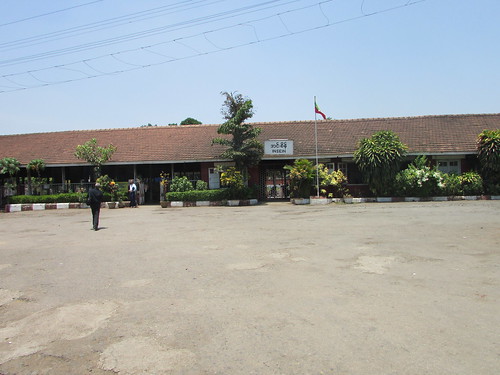 Road approach to Insein Station.
Road approach to Insein Station.
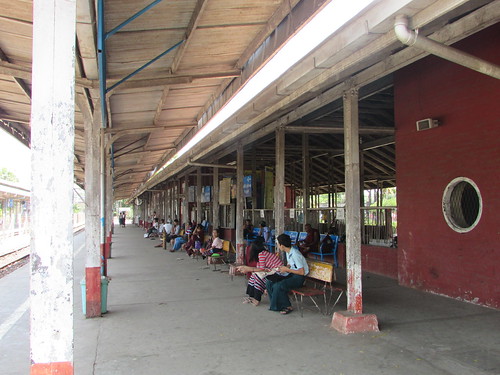 Insein, platform 1.
Insein, platform 1.
There's a concrete post and chain link fence in between platform 1 line and platform 2 line, to prevent too indiscriminate crossing of the lines by passengers but the fence is provided with an opening opposite the entrance from the main station building which most passengers choose to use, although there is also a steel footbridge linking the three platform groups [1], [2, 3], [4,5]. No fencing is provided between the other platform tracks. This arrangement is similar to some other stations in Myanmar.
Origins of Insein Station
Rail transport was first introduced in Myanmar in May 1877, when Lower Burma was a British colony, with the opening of the 163-mile (262 km) Yangon to Pyay line by The Irrawaddy Valley State Railway. This line passed through Insein. At that time, the Yangon terminus was at Kyee Myin Daing (about 5 miles south of Insein).
Track Layout
At Insein, the double track main line splits into five platform roads with two sidings on the west side. There are connections to the Locomotive Works on the west at both the south (apparently unused) and north of the station. There are connections to the Carriage Works on the east side at the south of the station.
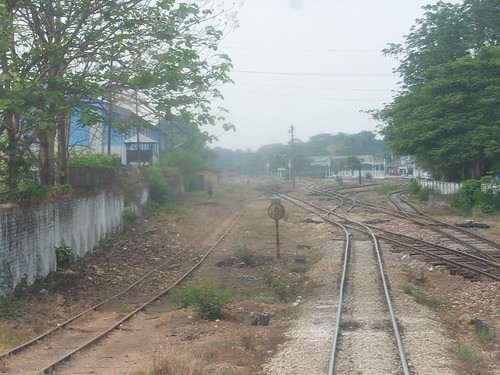 Cab view looking north as we approach Insein from the south.
Cab view looking north as we approach Insein from the south.
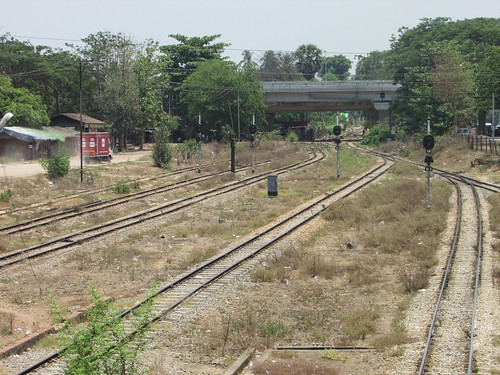 View of the north end of Insein Station, looking north.
View of the north end of Insein Station, looking north.
Signalling
'Home' signals in each direction are 2-aspect colour light with theatre-type route indicators.

Insein Up 'Home' 2-aspect signal '1R' displaying 'Yellow' with '5' displayed in the theatre-type route indicator for platform 5.
The station area is controlled by a 2-aspect colour light signals with position light subsidiary aspects.
 Insein: Showing 2-aspect colour light signals with position light subsidiary aspects and motor-driven trap points. DF.1240, having arrived with a terminating train from Yangon direction in platform 2 (on the left) and uncoupled now approaches the camera on platform 1 as it runs round.
Insein: Showing 2-aspect colour light signals with position light subsidiary aspects and motor-driven trap points. DF.1240, having arrived with a terminating train from Yangon direction in platform 2 (on the left) and uncoupled now approaches the camera on platform 1 as it runs round.
'Starting' signals in each direction are 3-aspect colour light and lead to automatic signalling sections.
Points are operated by electric point machines.
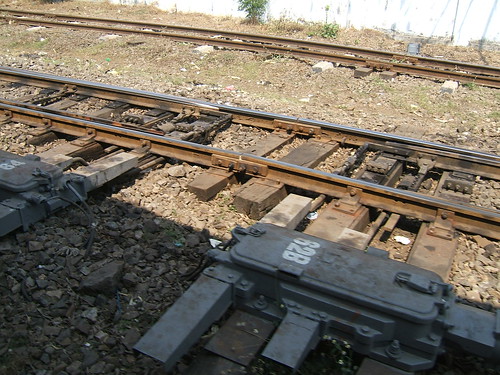 Insein in 2008: Two turnouts, 62B & 64, with electric point machines, insulated soleplates and insulated rail joints.
Insein in 2008: Two turnouts, 62B & 64, with electric point machines, insulated soleplates and insulated rail joints.
Signal Cabin at Insein
A 3-storey reinforced concrete building towards the south end of platform 1 accommodates the power-operated signal cabin.
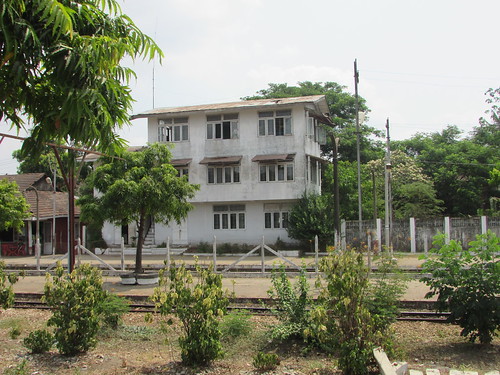 The Power Signal Box at Insein.
The Power Signal Box at Insein.
Insein Locomotive Works
In 2015, I had a conducted tour of the locomotive works which is described here.
 Insein: The building on the right is the Erecting Shop of the Locomotive Works. There is a long line of scrapped diesel locomotives alongside this building. Note the row of 2-aspect colour-light signals with position-light subsidiary signals (L to R: 8L/38L, 9L/39L, 10L/40L) and Location Case.
Insein: The building on the right is the Erecting Shop of the Locomotive Works. There is a long line of scrapped diesel locomotives alongside this building. Note the row of 2-aspect colour-light signals with position-light subsidiary signals (L to R: 8L/38L, 9L/39L, 10L/40L) and Location Case.
Insein Carriage Works
As yet, I've not found out much but note it's become the haunt of the 'new' second-hand diesel multiple units. In 2016 I found a new steel-framed workshop under construction.
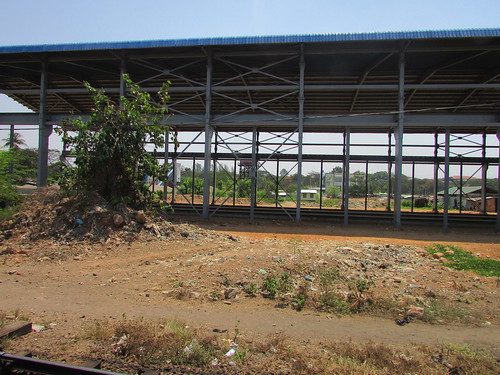 New steel-framed workshop under construction, Carriage Works, Insein.
New steel-framed workshop under construction, Carriage Works, Insein.
Background
I've collected information about Insein over a number of years, mainly through making trips around the Circle Line.
I first saw Insein in 2008 when I made a round trip on the Circle Line (described in the post The Circle Line, Yangon).
In 2012 I travelled on part of the Circle Line (report here) but didn't pass through Insein.
The following year, on 14th February 2013, I travelled from Yangon Central Station to and from the junction at Da Nyn Gone, producing pictures here and the post Yangon Area Railways.
On the 25th April 2014, I made a cab ride around the Circle line (see post Cab Ride around the Circle Line), and pictures here.
By 2015, the 'New' Diesel Multiple Units were being introduced and, on 4th May 2015, I went around the Circle line on one of these collecting more views in album The Circle Line by DMU.
Another 'New' Diesel Multiple Unit provided the motive power on 22nd April 2016 when I made another clockwise trip of the Circle Line with my young friend Aung (pictures here).
Finally, on Friday 6th May 2016 I took the Circle Line clockwise to Kyee Myin Daing and, after exploring around the station area, I continued to Insein for more exploring before returning to Yangon by an anti-clockwise Circle Line train (pictures at Yangon to Insein by Train.
Related posts in my blog
The Circle Line, Yangon (2008).
Exploring Yangon's railways.
Railway Signalling in Burma - Part 2: Colour Light Signals & Motor Points.
Railway Signalling in Burma - Part 6: Signal Boxes with Electrical Interlocking.
Yangon Area Railways
All my Myanma Railways posts.
My Pictures
Pictures in this article can be viewed uncropped by clicking on the image. To view in other resolutions or download, select from the album Insein Railway Station.
All my Myanma Railways Pictures.
